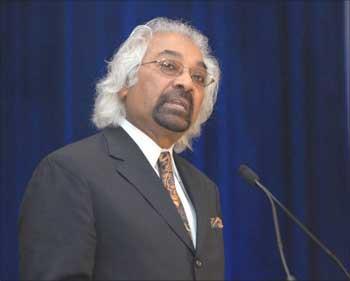 | « Back to article | Print this article |
 Sam Pitroda, chairman of India's knowledge commission and advisor to the Indian prime minister on public information infrastructure and innovations, is designing a program to democratise information in governance. The open government initiative between India and United States aims to help poor people access information for their better and faster development, he says.
Sam Pitroda, chairman of India's knowledge commission and advisor to the Indian prime minister on public information infrastructure and innovations, is designing a program to democratise information in governance. The open government initiative between India and United States aims to help poor people access information for their better and faster development, he says.
These are his grand plans, in his words:
"As a part of creating public information infrastructure, we want to connect 250,000 panchayats (villages) through fiber optics and broadband connectivity. This should be done to democratise information. Say, if farmers want expertise on seeds, best practices or input for weather they will be able to get it through a computer in panchayat offices.
Teachers would know about their subject through a teachers' network. It will improve teaching and help train teachers. Imagine entire India's nurses, doctors and lawyers connecting themselves to share their experiences. By sharing their knowledge, their knowledge will grow.
We are emotional, we like to connect. There is huge support in the system to spread this issue. Imagine the plight of people depending on a government pension. They would be able to access system through computers even in the villages.
The basic idea is to empower citizens with the help of information, improve health, agriculture and education. When you democratise information, you empower people. We will pull in UID (Unique Identity system), geographical indicators system, NREGA (National Rural Employment Guarantee Act), food distribution, school and college admissions, and anganwadi (rural women's empowerment program) kind of programs. Everyone should be able to know what others have and don't have.
Put information on a public platform, and the idea of development would change. Everyone is focusing on hard infrastructure like bridges and airports. I am talking about adding soft infrastructure. Open government is the infrastructure of tomorrow. Indian democracy can take the idea further on the global stage.
India will need billions of rupees to do it. But India got a unique advantage when India laid large amount of fiber (networks) underground. When it was done some 25 years ago, each fiber could carry 20 to 50 megabytes; but now technology has changed. Keep the fiber as it is but change the terminal's capacity - that can multiply the fiber's capacity. India has spare capacity of fibers laid underground. India has 800,000 km of fibers underground. We have exact location of it, street by street. We have maps and data. That asset is like gold. We want to use it. Another addition of 200,000 km of fiber optics will connect a larger part of the population.
I am optimistic. If you don't dream, it won't work. Power is coming to Indian villages. There are computers reaching the nooks and corners. The kids of India are so smart that this idea would work. The old guy in the panchayat may not use it but his grandson will. India should use technology in a creative way and in different ways than how the world is using it. The parents in villages may not use it, but their sons and daughters would use it to complain that the teacher in the village school is absent. In India, around 30 percent of teachers do not report regularly for their jobs. Health complaints are too many. Getting drugs, getting doctors' advice will become easy. Villagers will get resources that only city dwellers had so far. For repairing of agri-equipment, a farmer's son would get a video presentation. It's about taking technology to the lowest possible government infrastructure.
For teachers training, logistics are difficult. Town- and village-level teachers will be able to connect if we have software to connect and train them. I hope you know the story of Salman Khan's Khan academy of online learning. Why can't we teach our people like that? It is so simple! One guy sitting in his bedroom is teaching hundreds and thousands of people. Can you imagine it without broadband?
Once we start rolling, our villagers will improve the system themselves. They will make it user-friendly and will improve it to get jobs and save money. Indians are interactive people, and this is the interactive medium. In India we should have laptops and not desktops. Laptops have batteries, so power cuts can be tackled. Also, now computers are sturdier than before.
Trust the kids of India. When I started using computers, I read a manual; but my kids start playing computer games without learning from anybody.
If we connect 250,000 panchyats, we will be able to serve almost entire India. We have 700 million cell phones in the country. Every month we add 15 million more. In a few years, almost every adult will have a cell phone. India should use soft infrastructure to meet tomorrow's challenges and also make it global."
Image: Sam Pitroda
Photograph: Rediff Archives